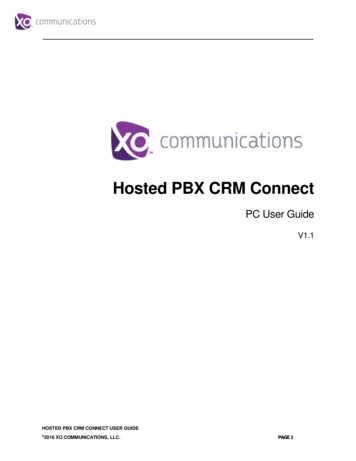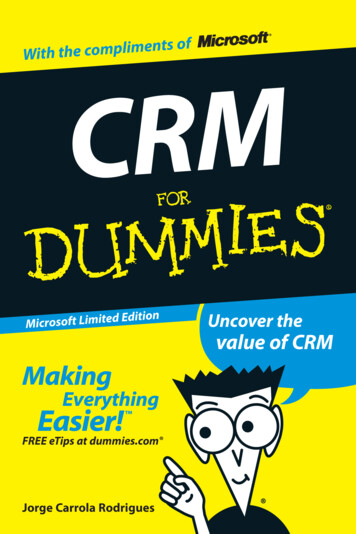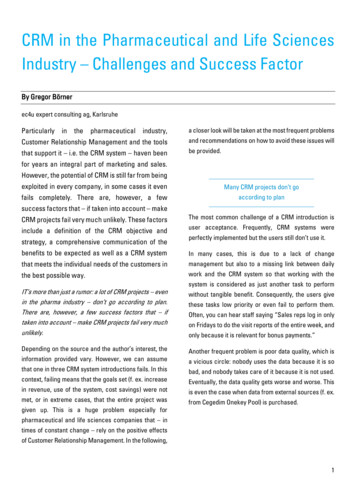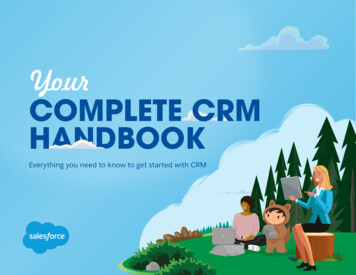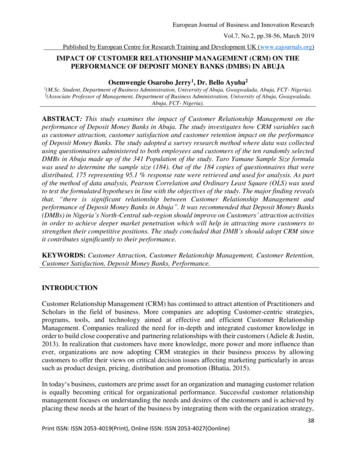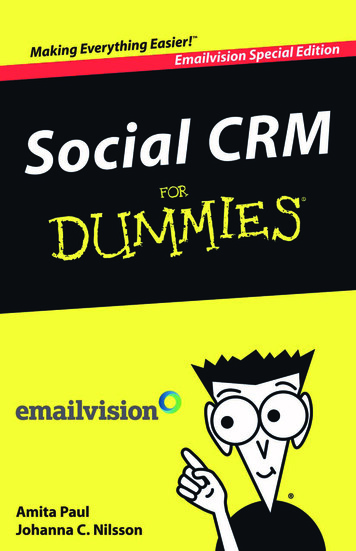
Transcription
About EmailvisionEmailvision is the worldwide leader in on-demand email and socialmarketing. The Emailvision mission is to provide excellence in technologyand services for online relationship marketing. The company is majorityowned by Francisco Partners of California, and is led by the same visionaryleaders who founded the company in 1999. With offices in 18 countries,Emailvision delivers four billion messages per month on behalf of more than3,000 clients worldwide. The organization provides a pioneering technologyplatform, industry-leading deliverability rates, in-depth relationships withmore than 150 global ISPs, and best-in-class client services. Emailvision’sunprecedented quality of service is driven by 12 years of research anddevelopment and by the organization’s 400 passionate employees who arededicated to helping customers harness the exceptional potential of emailand social marketing.Meet Emailvision on Social Networks: www.emailvision.com blog.emailvision.com www.facebook.com/emailvision www.twitter.com/emailvisionuk www.youtube.com/emailvisiontv www.linkedin.com/companies/emailvisionAmita Paul is a bright entrepreneur of the Social Media generation, andbrings with her over 15 years of product management and marketingexperience from a wide range of industries including retail management,email marketing, direct marketing, and information retrieval. In 2008, AmitaPaul founded a social media start-up called ObjectiveMarketer. UnderAmita’s leadership, the ObjectiveMarketer team developed an enterpriseclass marketing solution that manages and measures social mediacampaigns across all of the major social media channels. In 2011,ObjectiveMarketer was acquired by Emailvision. Amita is now working as aglobal Director of Social Media Marketing at Emailvision.Johanna C. Nilsson is the founder and principal of Herringbone, a SanFrancisco (California) and Stockholm (Sweden) based marketingcommunications firm specializing in social media marketing for clients whowant their voices heard in the global marketplace.
4PDJBM 3.FORDUMmIES‰By Amita Paul and Johanna C. Nilsson,EmailvisionA John Wiley and Sons, Ltd, Publication
Social CRM For Dummies Published byJohn Wiley & Sons, LtdThe AtriumSouthern GateChichesterWest SussexPO19 8SQEnglandFor details on how to create a custom For Dummies book for your business or organisation, contactCorporateDevelopment@wiley.com. For information about licensing the For Dummies brand forproducts or services, contact BrandedRights&Licenses@Wiley.com.Visit our Home Page on www.customdummies.comCopyright 2011 by John Wiley & Sons Ltd, Chichester, West Sussex, EnglandAll Rights Reserved. No part of this publication may be reproduced, stored in a retrieval system ortransmitted in any form or by any means, electronic, mechanical, photocopying, recording, scanning or otherwise, except under the terms of the Copyright, Designs and Patents Act 1988 or underthe terms of a licence issued by the Copyright Licensing Agency Ltd, 90 Tottenham Court Road,London, W1T 4LP, UK, without the permission in writing of the Publisher. Requests to the Publisherfor permission should be addressed to the Permissions Department, John Wiley & Sons, Ltd, TheAtrium, Southern Gate, Chichester, West Sussex, PO19 8SQ, England, or emailed to permreq@wiley.com, or faxed to (44) 1243 770620.Trademarks: Wiley, the Wiley Publishing logo, For Dummies, the Dummies Man logo, A Referencefor the Rest of Us!, The Dummies Way, Dummies Daily, The Fun and Easy Way, Dummies.com andrelated trade dress are trademarks or registered trademarks of John Wiley & Sons, Inc. and/or itsaffiliates in the United States and other countries, and may not be used without written permission.All other trademarks are the property of their respective owners. Wiley Publishing, Inc., is not associated with any product or vendor mentioned in this book.LIMIT OF LIABILITY/DISCLAIMER OF WARRANTY: THE PUBLISHER, THE AUTHOR, ANDANYONE ELSE INVOLVED IN PREPARING THIS WORK MAKE NO REPRESENTATIONS ORWARRANTIES WITH RESPECT TO THE ACCURACY OR COMPLETENESS OF THE CONTENTS OFTHIS WORK AND SPECIFICALLY DISCLAIM ALL WARRANTIES, INCLUDING WITHOUTLIMITATION WARRANTIES OF FITNESS FOR A PARTICULAR PURPOSE. NO WARRANTY MAYBE CREATED OR EXTENDED BY SALES OR PROMOTIONAL MATERIALS. THE ADVICE ANDSTRATEGIES CONTAINED HEREIN MAY NOT BE SUITABLE FOR EVERY SITUATION. THIS WORKIS SOLD WITH THE UNDERSTANDING THAT THE PUBLISHER IS NOT ENGAGED IN RENDERINGLEGAL, ACCOUNTING, OR OTHER PROFESSIONAL SERVICES. IF PROFESSIONAL ASSISTANCEIS REQUIRED, THE SERVICES OF A COMPETENT PROFESSIONAL PERSON SHOULD BE SOUGHT.NEITHER THE PUBLISHER NOR THE AUTHOR SHALL BE LIABLE FOR DAMAGES ARISINGHEREFROM. THE FACT THAT AN ORGANIZATION OR WEBSITE IS REFERRED TO IN THIS WORKAS A CITATION AND/OR A POTENTIAL SOURCE OF FURTHER INFORMATION DOES NOT MEANTHAT THE AUTHOR OR THE PUBLISHER ENDORSES THE INFORMATION THE ORGANIZATIONOR WEBSITE MAY PROVIDE OR RECOMMENDATIONS IT MAY MAKE. FURTHER, READERSSHOULD BE AWARE THAT INTERNET WEBSITES LISTED IN THIS WORK MAY HAVE CHANGEDOR DISAPPEARED BETWEEN WHEN THIS WORK WAS WRITTEN AND WHEN IT IS READ.Wiley also publishes its books in a variety of electronic formats. Some content that appears in printmay not be available in electronic books.ISBN: 978-1-119-97719-3Printed and bound in Great Britain by Page Bros, Norwich10 9 8 7 6 5 4 3 2 1
IntroductionFirst the bad news: You and your company no longer control marketing, sales, support, or product development.Your customers have taken over. They’ve stopped passivelysoaking up sales pitches and buying only the products andservices you choose to offer. They’re now active participantsin your business. Through the power of social media and networking, they can make or break you.The good news? Through social CRM (customer relationshipmanagement), you have the opportunity to harness the powerof consumers to market your products and services, improvecustomer satisfaction, provide support, and even developideas for new and improved products and services. This bookshows you how.About This BookWhen done right, social CRM has enormous potential forimproving and growing any business. Do it wrong, however,and social CRM has an equal potential for inflicting damage.Unfortunately, many businesses do it wrong. They start without a plan, drive away customers with pushy sales pitches,launch marketing campaigns without having analytics in placeto track customer response, and commit dozens of othersocial CRM no-no’s.This book shows you how to develop and implement a socialCRM strategy the right way.Foolish AssumptionsWhile writing this book, we made some assumptions aboutyou, the reader:
2Social CRM For Dummies You’ve heard about social CRM, social media, and socialnetworking, but you’re not sure how to use it to boostsales or improve your business. You want to do social CRM the right way and avoid themistakes most businesses make when first starting out. You’re willing to invest in social CRM, but you don’t wantit to completely consume your resources and frazzleyour personnel.How This Book Is OrganisedThis book is divided into six chapters, each covering a different aspect of social CRM. We also include a glossary so youcan quickly brush up on the lingo and a Social Media Rulebook, in For Dummies style, that you can start using right now.Chapter 1: Exploring theWorld of Social CRMThis chapter offers a brief introduction to social CRM andexplains how social CRM differs from traditional CRM anddirect marketing.Chapter 2: Gearing Upfor Social CRMIn this chapter, you discover how to lay the groundwork for asuccessful program.Chapter 3: Taking a MultichannelApproachIn this chapter, we explain how to coordinate a multichannelstrategy to connect with current and prospective customerswherever they may be — Facebook, Twitter, YouTube, youname it.
Introduction3Chapter 4: Cooking Upa Top-Notch SocialMedia CampaignThis chapter taps the power of social media to improve yourbusiness and boost sales and shows you how to automateyour efforts to stay in touch without straining your resources.Chapter 5: Optimizing Impactwith AnalyticsThis chapter shows you how to track your success, and constantly adapt your social CRM strategy and campaigns to theever-changing environment for maximum impact.Chapter 6: Ten Tipsfor Getting StartedAs an added bonus, Chapter 6 features ten tips ongetting your social CRM system up and running the right way.Icons Used in This BookThis book uses several icons to flag the most important items.When you see this icon, you know you’re about to read apractical tidbit that may save you time or money or improveresults.This icon marks information you should consider carefullyand never forget.Watch out! Follow this advice to sidestep a common and perhaps serious pitfall.
4Social CRM For DummiesWhere to Go from HereCheck out the chapter titles and section headings in this bookand start reading wherever you like. This book is writtenso that you can read it from start to finish without breakingstride, but if you want to jump to a specific topic, you can startanywhere to extract good ideas you can leverage immediately.If you want more information and advice on social CRM or thelatest in email marketing, visit www.emailvision.com.
Chapter 1Exploring the Worldof Social CRMIn This Chapter Comparing traditional and social CRM Noting the benefits of social CRM Identifying the challenges Establishing the right mindsetBeing competitive in today’s global economy hinges onthe ability to interact with consumers online via socialCRM (customer relationships management). In this chapter,you discover what social CRM is, its potential benefits, andways to approach it.Shifting Gears from Traditionalto Social CRMAlthough more and more companies are adopting the socialCRM model, many still engage in traditional CRM, which ischaracterized by the following: The focus is on marketing and selling to customers. The business initiates and controls most of the dialogue. Interactions tend to be direct and formal (professional). Customers play a very passive role.
6Social CRM For DummiesBut social media and networking have transformed the globaleconomy into something more like a small town marketplace,where community buzz, not marketing buzz, determineswhether businesses flourish or fail.Social CRM is a strategic response to this new business environment. With social CRM: The focus is on community and relationship building. Via social venues, including Facebook and Twitter, customers own and control the conversation. Communications are business-to-customer but also customer-to-customer and customer-to-prospect. Customers collaborate with businesses directly or indirectly to improve products, services, and the customerexperience. Conversation is less formal and more “real,” moving frombrand speak to community speak.Transitioning from traditional to social CRM calls for fundamental changes in your organization’s CRM model and approach.Table 1-1 highlights these changes.Table 1-1Moving from Traditional to Social CRMParametersTraditional CRMSocial CRMRolesCustomer serviceAll employees pproachContact managementCommunity managementChannelWell-definedDynamic and evolvingValuePeriodic connectionwith customerSustained customerengagementModelSimple transactionsComplex relationships
Chapter 1: Exploring the World of Social CRM7Harnessing the Powerof Your CommunitySocial media enables you to harness the power of communityparticipation and collaboration — two qualities inherent in socialmedia and essential in your social media strategy. Of course,inviting community participation presents some risk. You can’tcontrol what people say about your brands online. But you canmonitor their statements, respond to them, and engage with customers in a positive way that prompts constructive dialogue.Formulate a strategy that keeps the community front andcenter. Listen carefully to their insights, concerns, complaints, and needs and find creative, effective ways to participate in the dialogue.Knowing what’s saidabout your brandA big part of social CRM consists of monitoring the “airwaves” and knowing what people are saying about your business and brand. When you know what’s being said, you canbetter address customer needs and concerns.With social CRM, you gain access to early warning signs ofnegative press and dialogue — and, consequently, a platformfor addressing it and mitigating any damage.Being accessible and responsiveto customersBy establishing a social presence, you make it easier for customers and prospects to find and contact you, giving youmore opportunities to initiate and nurture relationships.Social environments also provide a channel for respondingquickly and effectively to customers.Respond to dissatisfied customers immediately and in waysthat create positive customer experiences. In a matter of minutes, a customer’s bad experience with a support person cango viral and damage your business’ reputation.
8Social CRM For DummiesRecruiting, supporting, andrewarding influencersEvery community has a few members everyone looks to forinformation, guidance, and recommendations. These individuals have a tremendous amount of influence in the community.These influencers also have the ability to increase your reachby spreading information, through commenting and sharing.Influencers help your messages go viral.Social media provides opportunities to identify these influencers and nurture positive relationships with them. The goal is totransform them into brand advocates.A good way to start identifying these key players is to establish your own social properties, such as a corporate blog,Facebook fan page, Twitter account, and YouTube channel.Using these tools properly increases your visibility and buildsa strong brand presence in the most active social settings.As you generate and distribute content, social CRM toolsenable you to monitor your community’s response and beginto identify the most influential members — those who spreadpositive word of mouth about your brand and whom othermembers look to for information and guidance.After identifying key influencers, your job is to equip andreward them. Following are a couple suggestions: Reward them with the proprietary information they needto strengthen their reputation as trusted authorities. Give them a “seat” on your community advisory boardso that they feel appreciated and respected and have avoice in your brand’s future.Influencers and brand advocates increase the reach and impactof everything you do to promote your brand. For more aboutempowering influencers and advocates, check out Chapter 4.
Chapter 1: Exploring the World of Social CRM9Identifying and profilinguser segmentsSocial media enables you to conduct focus groups and performsurveys with targeted demographics to better understandthe behavioral and geographic profile of your customers andprospects.Experimenting with different campaigns and messaging andmonitoring the response gives you a very good idea of whatmessage tone, theme, or product has the most positiveimpact . . . and which ones have a negative or no impact.For example, suppose you’re developing a promotionalcampaign for a product. You want it to include a picture of awoman and perhaps a short video. You could launch a campaign in the United States, at a certain time with a suggestivepicture of a woman, launch it at the same time of day in theUK, and then launch a third time in both locations with a moreconservative photo. In each case, you monitor the responseand consult the analytics (see Chapter 5).The ability to launch variations of a campaign gives you theopportunity to experiment with different parameters, including graphics, tone, message, video, and channel (for example,Facebook, Twitter, or YouTube). In the process, you gain valuable insight regarding your audience.Map your Facebook fans and Twitter followers with your emaillist. As you profile user segments, identify the most influentialmembers of the community and reward them with targeted andpersonalized emails, special offers, early notification of newproduct releases, and so on.Recognizing the Benefits ofBuilding a Social CRM ProgramMaking social CRM a central component of your businessmodel is a major undertaking, but the potential benefits aresignificant enough to convince even the most reticent to makethe investment. The following sections describe some of themany benefits.
10Social CRM For DummiesBoost customer retentionListening to and engaging positively with customers showsyou care and reinforces customer loyalty. It also enables youto discover more about them — their passions, lifestyles,activities, communities they belong to, and so on. This valuable data helps you provide for their needs.Switching to a different business is costly and inconvenient,so your customer’s first choice is to stick with you, as long asyou’re able to provide what they need.Social media enables you to proactively listen. It enables youto enter the environments where they’re talking about theirneeds and possibly discussing your brand. You show you careby being where your clients are, listening carefully to what theysay, and engaging in those discussions when appropriate.Show you care by Listening carefully to feedback, suggestions, and critiques. Responding in a timely manner. Proactively sharing updates about your business andbrand.Communicating and interacting with the community on a regular basis helps them feel connected and keeps them informedabout your company, products, and brands.Generate leadsProviding relevant content that addresses consumer needs,offers solutions to their problems, and helps them make themost of your products and services is one of the most effectiveways to generate leads. Current customers recognize the valueyour business offers, and they spread the word. Prospectivecustomers who see what you have to offer become more receptive to your products and services.Focus on nurturing relationships, earning trust, and offeringsomething of value. Social CRM is less about marketing andselling and more about offering real value and teaming upwith customers to improve their experience.
Chapter 1: Exploring the World of Social CRM11Turn leads into customersIf your business is set up in a way to automatically convertleads into customers, social media can help boost your conversion rates. First, make sure your customer conversion process is as automated, seamless, and hassle-free as possible,both online and offline: Online: Streamline the process for signing up for services or purchasing products. See how easy Amazon.commakes it and follow its model. Offline: If your sales process is to be completed offline,make sure that your sales department is ready to act onleads coming in from your website.Relationships are a two-way street. If you want people following you on Twitter, you better follow them, too. If you expectthem to show an interest in your business and brands, takean interest in them. Here are some ways to interact with yourcustomers: Read and comment on a customer’s blog as you wouldon a friend’s blog, to show you listen and care. Be supportive and share valuable knowledge and insights thathelp prospects achieve their blogging objectives. When others share valuable information that’s relativeto your business, industry, or brand, share it on Twitter,Facebook, and even your corporate blog (assuming thatyou have permission to do so). Follow others on Twitter and seek opportunities toretweet content that’s relevant to your community. If a community member has a relevant Facebook, become afan, monitor wall posts, and seek opportunities to contribute positively to the conversation. Promote relevant content that others post on YouTube,Flickr, Slideshare, and other content-sharing venues. Ratethe content, comment on it, and even share it on yoursite, if encouraged and permitted to do so. Consider contacting and interviewing a key influencer inthe community and featuring the individual in an articleor blog post that links to their social properties.
12Social CRM For DummiesDon’t use someone’s Facebook page as your organization’sself-promotional billboard. Respect and appreciate the factthat you’ve been graciously granted access to that space andshow your appreciation by contributing something of value.Reduce support costsFacilitating peer-to-peer support through discussion forumsmay actually reduce the costs of product support as customers answer questions and solve problems.Identify innovative ideasSocial dialogue often contains a wealth of information to fuelinnovation. A customer’s description of a problem may leadto a new product or service. Complaints about a product maylead to improvements in support and design. And customerfeedback often contains suggestions for improving the customer experience.Clearing a Few Small HurdlesEvery endeavor to improve customer satisfaction and business overall requires some effort and carries some potentialrisk. With careful planning, however, you can significantlymitigate the risks, maximize efficiency, and justify your ROI.The following sections explain how.Mitigating risksTo reduce the potential risks involved, you can Establish best practices and guidelines that are in line withyour corporate and brand (see Chapter 2). Implement procedures to establish a central plan for allyour social CRM activities. Provide training to ensure that everyone is on board andaware of policies and procedures.
Chapter 1: Exploring the World of Social CRM13Check out Chapter 2 for additional guidance in establishing astructure and process that makes social CRM more measuredand efficient and less prone to risk.Maximizing efficiencySocial media is not a part-time job. To prevent social CRM effortsfrom becoming a time and resource hog, online marketing managers or social community managers must Plan to be proactive in engaging with social communities. Automate communications through RSS-triggered or prescheduled campaigns to be as efficient and productive aspossible. Prioritize activities with dedicated resources to makeyour social CRM program scalable and sustainable.Justifying ROIKnowledge and analysis of key measurements transforms thesocial web from a source of largely unstructured qualitativedata into a marketing framework you can view and trackquantitatively.Data collection and analysis doesn’t need to be expensive, difficult, or controversial in respect to privacy issues. Combiningand interpreting or trending relatively simple measurementsprovides very useful insight. Social media analytics make allthis possible. (For more about analytics and estimating ROI,check out Chapter 5.)Seeing Social CRM in ActionSocial CRM strategies and implementation tend to vary according to industry. The following sections highlight the differentways key industries tend to use the social space to accomplishtheir goals and provide a case study for each industry.
14Social CRM For DummiesE-commerce case studyA small online retailer created alanding page on Facebook with aninvitation to “Like to access thesavings.” When users clicked theinvitation, they were redirected toa landing page tab with irresistiblecoupons that attracted several different client segments to their site.As a result, they not only increasedone-time online sales but also grewtheir fan and customer base to boostfuture sales.E-commerceGlobal giants, regional chains, and small online retailers areall embracing social media to Drive traffic to their websites and online outlets. Obtain and use customer testimonials. Advertise special promotions, coupons, and giveaways. Distribute product information.B2B companiesBusiness-to-business companies tend to use social media for Product innovation inspired by customers asking questions, suggesting improvements, or posting solutions toproblems they or others have had with a product. Customer service and education through press releases,how-to video tutorials, slideshows, industry articles,white papers, quarterly statistics, industry trends, worldnews, and so on.
Chapter 1: Exploring the World of Social CRM15B2B case studyA Fortune 100 technology companyimplemented a strategy of consistent messaging across all platforms,social media network automation,corporate blogging, and newsletterintegration. As a result, the organization experienced a dramatic increasein fans and followers and boostedoverall program participation withindependent software developersby 32 percent. This same companyrepurposed existing blog content forits newsletter and facilitated sharingit on numerous social media platforms. This approach helped expandcampaign reach beyond existingmembers and ignited new emailnewsletter signups.Publishers and authorsPublishers and their authors make extensive use of socialmedia to Launch books. Distribute information on new and upcoming titles. Distribute excerpts and other teasers. Enable authors to communicate more directly with readers. Distribute video, so readers feel a closer connection withtheir favorite authors.Publishing case studyA self-help author successfullysparked a viral campaign to promoteher upcoming book launch. Her promotional blast included a speakertour and a prepurchase offer on herFacebook fan page. She also sharedvaluable excerpts from the bookcomplete with chapter references,blogged about the topic, emailed allher contacts, tweeted regularly onTwitter, updated her LinkedIn profile,and reached out to colleagues andother contacts asking to help herpromote the book. The process notonly boosted initial sales far beyondwhat the publisher expected, butit did so almost instantly instead oftaking the usual five to six weeks.
16Social CRM For DummiesEntertainment and eventsThe entertainment industry and event planners are oftenskilled at tapping the full power of social media for Event promotions to generate buzz. Ticket sales, event registration, event date, and venuedetails. Sponsor exposure and details about the event host. Brand awareness and increased customer participationenabling customers to upload photos for tagging onFacebook and other platforms.Real estateTech-savvy real estate agents have a strong social presence,leveraging social media’s power to Establish themselves as credible, trusted resources. Generate leads by offering valuable insight and informationand free appraisals (depending on location). Connect with colleagues in other locations to help clientswith long-distance moves.Event case studyA high-profile event company created a content and communicationcampaign with the goal of maximizing participation and increasingsubscriptions to future events. Itsstrategy included the use of socialmedia before, during, and after everyevent.By using landing pages with relevantcontent also shared on Twitter, acall to action for event registration(“Click and bring a friend to get 20%off”), and a user subscription form,the company made the campaign goviral. To increase reach, it distributedsocial media content to influentialcommunity members who spreadthe word.Though the work involved was stillconsiderable, the company wasable to preschedule a huge amountof content using its social CRM system’s bulk scheduling feature.
Chapter 2Gearing Up for Social CRMIn This Chapter Implementing policies and procedures that work Establishing an effective, efficient system Streamlining activities with the right technology Getting everyone on board and in-the-knowSocial CRM isn’t a simple add-on to your current CRMstrategy and system. It’s fundamentally a new way ofdoing business that requires company-wide policies, procedures, technology, and training. This chapter explains how togear up for social CRM with these four essential components.Setting PoliciesSocial CRM success begins with policies and a system (see thenext section). Policies ensure that all personnel know what’sexpected of them.Before anyone in your organization posts content or interactswith customers online, establish the rules of engagement.Be sure that everyone gets a copy of them, fully understandsthem, and grasps the importance of adhering to them.Your corporate rule book should cover the following policies: Who’s authorized to represent the organization onlineand post content. How to identify yourself online. Limitations to making commitments on the organization’s behalf.
18Social CRM For Dummies Posting of confidential or copyrighted information,including financials. Whether and how to engage with news media. Whether and how to discuss competitors. Rules against posting anything offensive or engaging inonline disputes. Individual responsibility to act in the best interest of theorganization.Policies and guidelines should be clear, but make them flexible enough to empower personnel to have genuine, humaninteractions with customers and the community. If you’re ina strictly regulated industry, however, your communicationsor public relations (PR) department may need to filter anycontent posted online and notify all personnel: No postingwithout PR’s okay. See Appendix B for a sample social mediarule book.Many large companies post their social media policies andguidelines on the web. Reference these valuable resourceswhen developing your own policies and guidelines.Developing an Effective SystemTo be effective and efficient, social CRM must be systematic.Every customer interaction must be logged, and every relevant mention of your business online must be identified,recorded, and, in many cases, responded to.Having a system in place saves time and money, coordinatespersonnel and activities, ensures regular communication withcustomers and prospects, improves impact, and reducesopportunities for error.An efficient, reliable system must address four areas (seeFigure 2-1): Monitoring
6 Social CRM For Dummies But social media and networking have transformed the global economy into something more like a small town marketplace, where community buzz, not marketing buzz, determines whether businesses flourish or fail. Social CRM

